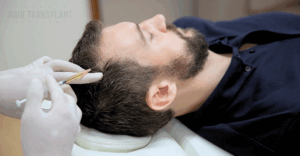Crown Hair Transplant: Hair Restoration in Toronto | Replace Your Hair Naturally – THTS
Hair loss is a common issue faced by many individuals, and one area that is particularly affected is the crown of the head. The crown, also known as the vertex, is the topmost part of the head. Hair loss in this area is often due to androgenic alopecia, the medical term for male and female pattern baldness, which is caused by sensitivity to dihydrotestosterone (DHT) and leads to progressive thinning and baldness on the crown. Crown hair loss often experiences progressive thinning for a prolonged period of time, which can spread outward in a sunburst fashion. It can suffer from anything ranging from a small visible gap to generalized thinning that spreads outward from the center. Many people first notice a bald spot in the crown area, which can be emotionally impactful. In this comprehensive guide, we will explore the aggressive solution to at the crown, including restoration and stabilization techniques, recovery, long-term strategies, and more.
Understanding the Crown Hair Loss
The crown area is prone to ongoing recession, especially in individuals experiencing male pattern baldness. Bald spots are common in the crown region due to male pattern baldness, and specialized procedures are often required to restore hair in these problematic areas. This means that additional hair restoration sessions may be required in the future to cover further baldness that may occur in this area. It is important to note that individuals under 35 years of age may not be suitable candidates for crown hair transplantation, as the crown area will continue to lose hair over time and there may not be a sufficient amount of donor hair to cover the balding area in the future.
Crown Hair Transplant Procedure
1. Extensive Grafting for Excellent Results
Crown hair restoration requires an extensive number of grafts to achieve optimal outcomes. The crown area often needs more hair to provide adequate coverage due to its visibility and the viewing angle. The crown area requires a large number of grafts for effective hair restoration due to the unique hair growth pattern. Using healthy hair follicles from the donor area is essential to ensure successful and long-lasting results. Depending on the extent of baldness, multiple sessions may be necessary to achieve the desired density. It is crucial to consult with a hair transplant specialist to determine the number of grafts and sessions required for your specific case, as meticulous technique is essential to achieve a natural appearance in the crown region.
2. Addressing Front and Crown Areas
If both the front and crown areas of the head experience significant hair loss, it is essential to address them separately to avoid unnatural results and lack of density. Crown transplants present unique challenges and require careful planning to ensure successful outcomes and realistic expectations. Unless a mega session (over 3,000 grafts) is performed, addressing the front, center, and crown areas simultaneously may not yield the desired outcome. The candidacy for this procedure should be evaluated to determine the most effective approach.
3. Medical Management for Crown Hair Transplant
Individuals considering crown hair restoration are advised to be on medical management, such as finasteride and/or minoxidil, to slow down further hair loss in the crown area. These medications are used to promote hair growth and increase hair density in the crown area. A comprehensive approach to crown hair loss may include a combination of hair restoration treatments tailored to the individual’s needs. This proactive approach helps minimize the need for additional transplant sessions in the future. It is especially recommended for younger individuals contemplating crown hair transplantation.
FUE Hair Transplant Surgery
FUE (Follicular Unit Extraction) hair transplant surgery has become a leading choice for those seeking to restore hair loss in the crown area. This minimally invasive procedure involves the careful extraction of individual hair follicles from the donor area—typically the back and sides of the scalp, where hair is most resistant to balding. Each follicular unit is then precisely transplanted into the thinning or balding crown area, allowing for a natural looking result that blends seamlessly with your existing hair.
One of the main advantages of FUE hair transplant surgery is the minimal scarring it leaves behind, as there are no large incisions or stitches required. The procedure is performed under local anesthesia, ensuring patient comfort throughout. Depending on the number of grafts needed to achieve your desired hair density, the surgery can take several hours, but the recovery time is generally quick. Most patients appreciate the natural looking results and the youthful appearance that FUE hair transplant surgery can provide, making it an excellent option for those looking to address crown hair loss with a minimally invasive procedure.
Donor Area Importance
The success of any crown hair transplant procedure relies heavily on the quality and availability of donor hair. The donor area, usually found at the back and sides of the scalp, contains hair that is genetically programmed to resist hair loss. Having sufficient healthy donor hair is essential for achieving a natural looking result and optimal hair density in the crown region.
A skilled hair transplant surgeon will thoroughly assess the donor area during your initial consultation, considering factors such as hair density, texture, and color to ensure the best possible match for your crown hair. The health and preservation of the donor area are top priorities at a reputable hair transplant clinic, as overharvesting can compromise future procedures and the overall appearance of your hair. By entrusting your hair restoration to an experienced team, you can be confident that your donor area will be managed with care, maximizing your chances for a successful and natural looking outcome.
Causes of Crown Hair Loss
Hair loss in the crown area is commonly associated with male pattern baldness in men. Women can also experience hair loss in this area due to various conditions, although the pattern is typically more dispersed. Some conditions that may result in crown hair loss include alopecia areata, anagen hair loss, cicatricial alopecias, disorders of hair growth, inflammatory scalp conditions, telogen hair loss, tinea capitis, traction alopecia, and trichotillomania. The nature and progression of these conditions determine the appropriate treatment, which may involve medication or surgical intervention. Dr. Jonathan Huber is trained to assess each case and recommend the safest and most successful treatment approach.
Determining whether hair restoration surgery is the best option for treating crown hair loss requires careful consideration of several factors. These include the extent of hair loss, the likelihood of future hair loss, the availability of sufficient donor hair to address new balding areas, and the ability to create natural-looking hair patterns through transplantation. Follicular unit transplantation (FUT) is a primary surgical method used to restore hair in the crown area. This procedure effectively restores hair in the crown region, improving overall appearance and confidence. A crown hair transplant can provide permanent hair restoration, meaning the transplanted hair will continue to grow and thrive for the long term. During the initial consultation, you will receive expert advice on the most suitable crown hair restoration options for your specific situation. Crown hair transplants offer permanent hair restoration, as the transplanted hair is typically permanent and resistant to future hair loss.
Recovery from Crown Hair Transplant
Recovery from a crown hair transplant is similar to recovery from other types of hair transplant surgery. The recovery duration depends on the donor hair harvesting method (linear harvesting or follicular unit extraction), the size of the coverage area, and the number of grafts required. The recovery following a crown hair transplant takes 5-10 days with most patients back to work around 10-11 days after their surgery. Generally, patients can resume most daily activities within 24 hours after surgery. However, it is advisable to avoid strenuous activities for about a week to prevent accidental injury and reduce the risk of bleeding.
Many individuals choose to take a few days off work following the procedure. During recovery, expect some scabbing in the transplanted area, which typically resolves within a week. There is no need for bandages; you can wash your hair the day following the surgery. If desired, you can wear a hat or cap immediately after surgery to conceal any scabs.
Patients can expect to see full hair growth in the crown area over the months following the procedure. Hair transplant results in the crown area may take longer to fully mature compared to other regions, but the final outcome is typically very rewarding. Patients typically see their final crown hair transplant results around 12 months following their procedure, although some may see results as early as 9 months or take up to 18 months to see full results.
Hair Restoration Timeline
Understanding the hair restoration timeline helps set realistic expectations for your journey to fuller hair. In the first few weeks after your hair transplant, it’s normal for the newly transplanted hair to shed as part of the healing process. This is a temporary phase, and with proper post operative care, the transplanted hair follicles will begin to establish themselves in their new location.
New hair growth typically starts to become visible within three to four months, gradually increasing in density and coverage over the following months. Most patients see significant improvements in hair growth and overall appearance between 12 and 18 months after the procedure. Regular follow up appointments with your hair transplant surgeon are important to monitor progress and address any concerns along the way. With patience and diligent care, you can look forward to a natural looking, youthful appearance and restored confidence as your hair restoration journey unfolds.
Cost of Crown Hair Transplantation
The cost of crown hair transplantation can vary significantly from patient to patient. Factors such as the area of hair loss to be covered and the desired hair density can influence the number of grafts required during the procedure. In some cases, multiple procedures may be necessary. The individualized nature of crown hair transplantation costs necessitates discussing the details during an initial consultation.
Choosing a Surgeon
Selecting the right hair transplant surgeon is one of the most important decisions you’ll make on your hair restoration journey. An experienced and knowledgeable hair transplant specialist will assess your unique hair loss pattern, evaluate your donor area, and recommend the most suitable hair transplantation technique for your needs. Look for a reputable hair transplant clinic that prioritizes patient safety, uses advanced minimally invasive techniques, and has a proven track record of natural looking results.
Take the time to research potential surgeons, review before-and-after photos, and read patient testimonials. During your initial consultation, ask about the surgeon’s experience with crown hair transplants and their approach to achieving optimal results. By choosing a dedicated and skilled professional, you can feel confident that your hair restoration will be handled with expertise and care, leading to a successful and satisfying outcome.
Before and After Results
Before-and-after results are a powerful way to see the transformative potential of crown hair transplant procedures. Patients who undergo hair transplants at a reputable hair transplant clinic often experience dramatic improvements in hair density, coverage, and overall appearance. The newly transplanted hair is meticulously implanted to mimic the natural growth pattern, ensuring a seamless and natural looking result that blends with your existing hair.
Reviewing before-and-after photos can help you set realistic expectations and visualize the possibilities for your own hair restoration. A skilled surgeon will showcase a portfolio of successful cases, demonstrating their commitment to delivering exceptional, natural looking results. With proper care and expert technique, you can achieve a fuller, more youthful appearance and enjoy renewed confidence in your overall look.
Hair Transplants FAQ
How much does a hair transplant cost?
The cost of a hair transplant depends on the procedure type and the number of grafts transplanted. Dr. Jonathan Huber focuses on manually performing the procedures for the most natural look possible. Hair transplant procedures generally start at $6,000.
Is it possible to achieve a natural-looking result?
Yes, Dr. Sharma’s artistic eye and years of experience ensure that the results of hair transplants look as natural as possible. The goal is to create a hairline that appears untouched by any surgical intervention.
What is the recovery process like?
After a hair transplant, patients typically experience swelling, tightness, and discomfort in the scalp. Temporary scabbing is also common during the healing process. Dr. Jonathan Huber provides after-care instructions and personal follow-ups to ensure a smooth recovery.
Talk to a Hair Transplant Expert
If you are considering hair restoration options for crown hair loss, our experienced team is here to assist you. Whether you are a Toronto resident or choosing our clinic as your hair transplant surgery destination, we are just a phone call away. Contact Toronto Hair Transplant to schedule a consultation and learn more about how our modern treatments can help you regain a confident, full head of hair.





